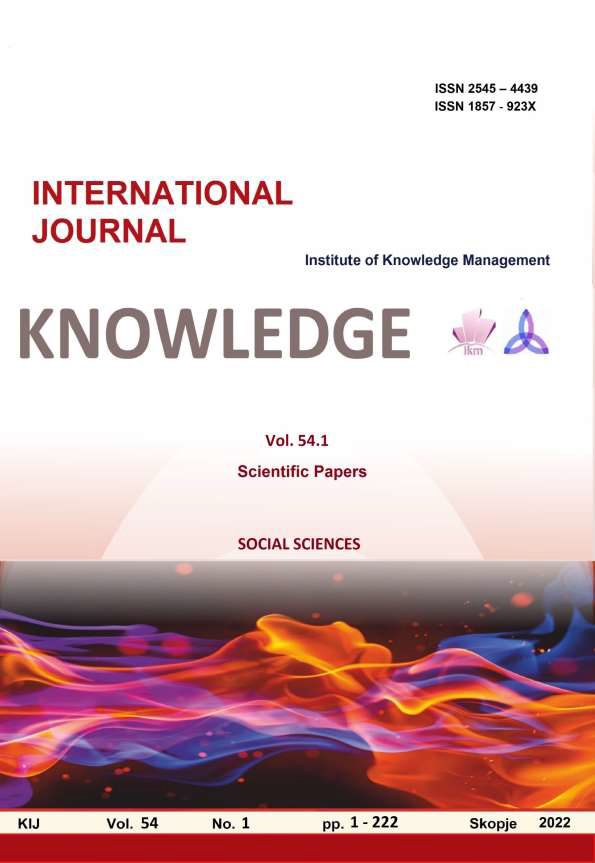THEORETIC OVERVIEW OF CIRCULAR QUESTIONS IN FAMILY AND SYSTEMIC THERAPY
Keywords:
circularity, circular questions, family therapyAbstract
Circular causality focuses on the reciprocal relationship between two events. The perspective of
reciprocal relationships stems from the foundations of cybernetics, which refers to the regulatory action where one
part of the system impacts another. This has helped the family therapist to make a change in how they view and
understand interactions and to move away from linear causality where the intent of questioning is predominantly
investigative, to circular questioning where the intent is to focus more on relational context and on the interactions
between two events. While linear causality implies a process in which one event causes occurrence of another (or A
causes B and B doesn’t have any influence of A), circular causality implies that B has influence over the event A.
Circular questioning is used in family therapy to yield information about the dynamics and relationships in a family.
It was first introduced by the Milan Associates in their paper highlighting hypothesizing, circularity, neutrality as
central guidelines for conducting a session. And it was use as means for conducting a systemic investigation of the
changes and differences in family relationships which recursively support dysfunctional interactions or symptoms in
the family. Circular questions allow the therapist to better understand the system and explore its nature and to
explore the recurring contextual patterns of connection that make up the family system. It also represents a thorough
investigation of the behavioral and ideological connections between the evolution of the presenting problem,
changes within family relationships, and interactions around these dynamics reveals the family circle of
relationships. It offers a change in family perspectives and encouraging family members to imagine how others think
and feel by exploring the relationships within the family and introducing new ideas and ways of thinking to seeing
things differently. This paper focuses on circular questioning theoretical basis. The aim is to make a brief review of
the various types of circular questions and to clarify how these questions are applied in practice. By this we believe
we will contribute to better understanding their essence and application in therapy. In this sense, we review the
principle of circular questions, rules for submitting a circular question and we discuss the four categories of circular
question: problem-oriented questions, questions oriented on the sequence of interactions, question for comparison -
classification and intervention circular questions. Circular questions are essential in family and systemic practice,
their importance comes from their purpose - to generate multiple explanations and stories from a family situation
and stimulate the curiosity of the therapist while avoiding their temptation to seek a one definitive explanation.
References
Bateson, G. (1972). Steps to an ecology of mind. New York: Ballantine Books, 1972..
Bateson, G. (1979). Mind and nature: A necessary unity. New York: Dutton.
Bateson, G., & Donaldson, R. (1991). A sacred unity: Further steps to an ecology of mind (1st ed.). New York: HarperCollins.
Evans, N., & Whitcombe, S. (2016). Using circular questions in qualitative research. Nurse Researcher 23 (3) , pp. 26-29. 10.7748/nr.23.3.26.s6
Goldner, V. (1985). Feminism and family therapy. Family Process, 24, 31-47.
Hoffman, L. (1981). Foundations of family therapy: A conceptual framework for systems change.
Kelledy, L., & Lyons, B. (2019). Circular Causality in Family Systems Theory. In: Lebow, J.L., Chambers, A.L., Breunlin, D.C. (eds) Encyclopedia of Couple and Family Therapy. Springer, Cham. https://doi.org/10.1007/978-3-319-49425-8_248
Keeney, B. P. (1983). The aesthetics of change. New York: Guilford.
Keeney, B. P. (1985). Mind in therapy. New York: Basic Books.
Minuchin, S., & Fishman, C. H. (1981). Family therapy techniques. Cambridge, MA.: Harvard University Press.
Palazzoli Selvini, M., Boscolo, L., Cecchin, G., & Prata, G. (1978a). Paradox and counterparadox A new model in the therapy of the family in schizo,nhrenic transaction, New York: Jason Aronson.
Palazzoli Selvini, M., Boscolo, L., Cecchin, G., & Prata, G. (1978b). A ritualized prescription in family therapy: Odd and even days. Journal of Marriage and Family Counseling, 4, 3-9.
Palazzoli Selvini, M., Boscolo, L., Cecchin, G., & Prata, G. (1980). Hypothesizing-circularityneutrality: Three guidelines for the conductor of the session. Family Process, 19,3-12.
Papp, P. (1983). The process of change. New York: Guilford Press.
Penn, P. (1982). Circular questioning. Family Process, 21, 267-280.
Piercy, F. P., & Sprenkle, D. H. (1984). The process of family therapy education. Journal ofMarital
Riche’, M., & Rosenthal, D. M. (in press). Adolescents and families: Therapy for whom and for what.
Stagoll, B. (2006). Gregory Bateson at 100. Australian and New Zealand Journal of Family Therapy, 27(3), 121–134.
Smith, M., & Karam, E. (2018). Linear Causality in Family Systems Theory. In: Lebow, J., Chambers, A., Breunlin, D. (eds) Encyclopedia of Couple and Family Therapy. Springer, Cham. https://doi.org/10.1007/978-3-319-15877-8_285-1
Sholevar, G. P., & Schwoeri, L. D. (2003). Textbook of family and couples therapy: Clinical applications (1st ed.). Arlington: American Psychiatric Association Publishing.
Tomm, K. (1985). Circular interviewing: A multifaceted clinical tool. In D. Campbell & R. Draper (eds.), Applications of systemic therapy: The Milan approach. London: Grune & Stratton
Tomm, K. (1987). Interventive interviewing: I. Strategizing as a fourth guideline for the therapist. Family Process 26: 3-13,
Thomas, F. N., Waits, R. A., & Hartsfield, G. L. (2007). The influence of Gregory Bateson: Legacy or vestige? Kybernetes, 36(7/8), 871–883.
Watzlawick, P., Weakland, J., & Fisch, R. (1974). Change: Principles of problem formation and problem resolution. New York: W. W. Norton.
Weeks, G. R., & L'Abate, L. (1982). Paradoxical psychotherapy: Theoly andpractice with indiuiduals, couples, and families. New York: BrunneriMazel.





